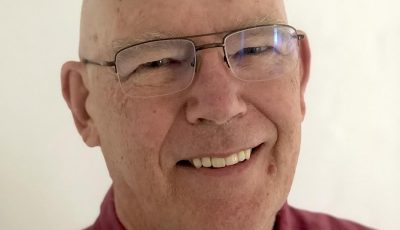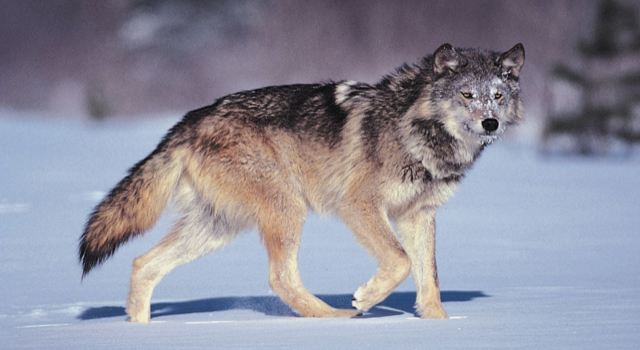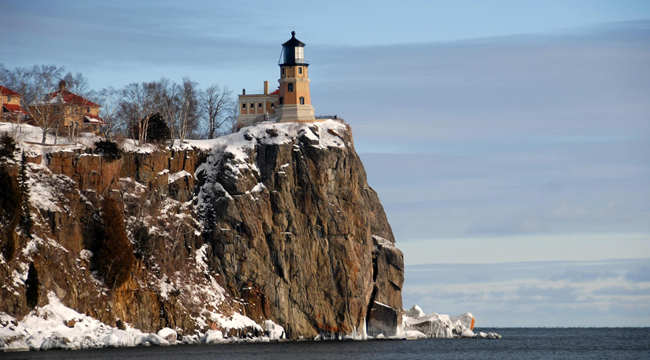

Africa Scene: Stanley Trollip
- A Howling Solo Debut
Full disclosure: Stanley Trollip and I write the Detective Kubu mysteries together. So I know he’s an excellent writer with clever plot ideas—but even I was surprised by the intriguing premise, suspense, and twisty plot of his first “solo” mystery, WOLFMAN, set in Duluth.
If you think I may be biased, here’s what Julie Kramer, author of the Riley Spartz series and national award-winning investigative producer, said: “WOLFMAN is a howling good read. Stanley Trollip delivers a suspenseful nature vs. news thriller that will have readers fearing and cheering the big bad wolf.”
Trollip was born in Johannesburg and now splits his time between Cape Town and Minneapolis. In this interview for The Big Thrill, he talks more about writing “solo” and the inspiration behind his thrilling new release.
Crystal Nguyen is an intriguing protagonist. She’s driven in her career and her sport, and she’s passionate about the environment. As an American born in Vietnam, she remains an outsider. Where did she come from?
After our fourth Detective Kubu novel, we were concerned about getting stale and decided it was time for a change. So we decided to write a thriller instead of a police procedural and set it in South Africa instead of Botswana. Since rhino poaching is a huge issue in South Africa, we realized it would provide a good backstory. At the time, about 1,000 rhinos were being slaughtered each year for their horns, each of which could have a street value of up to nearly half a million dollars. You can imagine what people are willing to do when that amount of money is at stake.
We also wanted to give ourselves a serious writing challenge, so we set about trying to decide who should be the protagonist of the new book. After much discussion, we decided it should be an investigative reporter who could be looking to do a story about rhino poaching. I then suggested that it should be a woman, since our other protagonist, Kubu, is a man. Once we agreed on that, I suggested a Vietnamese woman who was a refugee after the war, living in Minnesota. I opted for a Vietnamese woman because Vietnam is at the center of the rhino-horn trade, and it would be useful for the story to have someone who could go there, be relatively inconspicuous, and speak the language. I suggested Minnesota, since I had already lived in Minneapolis for 30 years.
We had serious problems with the book, running into a wall a couple of times at about 20,000 words. Each time that happened, we took a breather and wrote another Kubu mystery.
Eventually, I suggested to Michael that our problem was that we didn’t really understand our new main character, Crystal Nguyen. I offered to write a few stories about her, set in northern Minnesota where she worked as an investigative reporter for a Duluth TV station. Those few stories ended up being about 60,000 words, and that solved our problem. We returned to the thriller and finished it successfully. It was published in the UK first as Dead of Night and in the USA as Shoot the Bastards.
When COVID appeared and I was severely locked down in Cape Town, South Africa, I realized that I had an unpublished novel sitting on my hard drive—at least the first draft of one. So I set to work, rewriting it, tightening it, and refining the overall story.
So, in essence, WOLFMAN, which is what I called my novel, is a prequel to Shoot the Bastards.
Employed to report on environmental issues for a TV station in Duluth, Minnesota, Crys finds herself doing the typical cub-reporter job. Her break comes with the trial of two wolf poachers and a fiery report that she presents on air. After that, her relationship with her boss, Scott Hansen, goes up and down with the ratings and the threats from angry hunters. Does this ignite the tension for the rest of the story?
Crys’s relationship with Hansen is always tense. In fact, the book starts with her rehearsing what she will tell him when she hands in her resignation letter. Before she can do that, two hunters are found not guilty of wolf poaching despite the fact they have numerous wolf pelts in their possession. Hansen is incensed that they got off and gives Crys the opportunity to report on it in prime time, with the admonition not to mention hunters. She doesn’t use the word, but calls them barbarians instead, which ignites a heated debate in the community, which is her goal, and draws anger from her boss.

The protagonist in Trollip’s new thriller, WOLFMAN, is passionate about wolves, like this gray wolf.
She keeps putting him in difficult positions when she pushes his boundaries, sometimes going against his orders. However, her reports cause the station’s ratings to soar. Without the ratings, he would have fired her.
When it becomes apparent that her life may be in danger, first from poachers that she goes after, then from a so-called ally of hers who doesn’t think she’s doing enough, her boss becomes very protective. Of course, she wonders whether he’s trying to protect her or the ratings.
Crys has a particular passion for wolves and is tempted to become involved with movements like Hunt the Hunter, which targets hunting. Is it based on a real group?
When I first read this question, I knew how I would answer it. However, with a little research, the answer is not as clear. A few years ago, perhaps even within the last year, there was a Facebook group for Hunt the Hunter. Now it no longer exists. I suspect that it was taken down because it advocated, at least in the title, violence against hunters. If my memory serves me correctly, there were photos of trophy hunters standing over the animals they had killed.
So to answer your question, yes I believe there is such a group, but now its public face seems to be in hiding.
In WOLFMAN, Crys commits the journalistic sin of creating a story that she then reports on. A mysterious person called LUPUS tips her off about poaching, and she takes action. Then a copycat appears, and soon things get out of hand. Was this how you planned the story to develop, or did it evolve on its own?
I am a pantser at heart. That means that I have a broad sense of the story, but let it go where it takes me. As mentioned above, I originally thought I would write a few chapters about Crys, trying to understand better who she is and how she would behave in different circumstances. I did plan the furor over her initial reporting and the unexpected opportunity she had to strike at some poachers and then report on what she’d done. Then it seemed necessary to have someone who knew the area to guide her to various poaching activities so she could continue her activism. The anonymous LUPUS fitted that role very well, and she was able to continue her activities.
As it became obvious that poachers were being targeted, she speculated in one of her reports that there was someone out there, a Wolfman, who was responsible for what was happening. The idea went viral, sparking a vigorous discussion about poaching within the hunting community, which was what Crys had hoped for.
The Wolfman idea was fine, but needed some bad consequences for Crys. So what better than to introduce a like-minded person, a copycat, who wanted to go after hunters in a much more dangerous way? Now Crys is forced into deciding to continue on her path or pull back to prevent people being killed. So she pulls back and tries to downplay the Wolfman. Unfortunately, the copycat then regards her as an enemy and goes after her as well as after poachers.
Each of the twists in the story evolved because of a dramatic need. That is the nature of writing by the seat of one’s pants.
Crys is really a loner, but while investigating her story, she makes contact with an environmental officer, Chuck Gustafson, who is a kindred spirit. He seems to be helping her, but she fears that he may have guessed her personal involvement, so she keeps her distance. How did you conceive his role in the story?
The Department of Natural Resources (DNR) plays a prominent role in all matters around hunting, including the ability to apprehend poachers. It’s just not possible to have a story about hunting and poaching in Minnesota without involving someone from the DNR. So Chuck becomes her go-to person whenever she needs information about poachers or poaching. As the story grew from a few chapters into a novel, he needed to become more prominent. After a few of her excursions against poachers, and after her speculation that there is this Wolfman out there, she starts to fear that he suspects that Wolfman is real, and that it’s her. That causes the relationship to chill.
All your previous novels are set in southern Africa. WOLFMAN is in a completely different context—Duluth in winter, gray wolves, American-Vietnamese culture. How did you go about researching these?
I have lived in Minnesota since 1983 and have experienced many frigid winters. So knowing how a Minnesota winter feels required no research. I was also an avid cross-country skier, so I understand a lot about that. However, I am not a biathlete like Crys. So I read a lot about the biathlon, what it takes, and what sets great skiers apart from ordinary ones. I also visited Mt. Itasca Biathlon Center and spent several hours talking to one of the country’s top coaches, Vladimir Cervenka. I discovered that while I could shoot quite well lying down, I could barely hit the target when standing even with normal heart rate. How someone can ski hard for many kilometers, then shoot accurately without taking time for the heart to slow down is beyond me.
There is a rich literature about gray wolves, so learning about them was straightforward.
There is also a rich literature about the Vietnamese experience in America, as well as how Vietnamese families have coped in such a foreign environment. Visits to the Vietnamese Community Center in St. Paul, Minnesota, helped answer some questions. Conversations with younger Vietnamese here in the States helped me understand some of the generational dynamics in immigrant families—an issue that is fundamental to Crys’s character.
Crys is a world-class competitor in the biathlon. Her best friends are her trainer and his wife. Why is the biathlon important to the story?
The biathlon is an extremely taxing sport requiring amazing levels of fitness, as well as great skill. Having Crys be a top biathlete serves two purposes. The more important one is that the biathlon became a metaphor for Crys herself. To succeed requires dedication, discipline, and the ability to shrug off failure. Although some of her journalistic behavior appears to be ill-disciplined and even ditsy, it is part of her drive to protect endangered species, specifically gray wolves. In that, she is also dedicated, disciplined, and will bounce back after a failure.
It is also a metaphor for the northwoods, where there is peace and tranquility represented by the cross-country aspect of the biathlon, and violence represented by the shooting aspect.
The fact that she is a serious contender in her biathlon races is also a foil for her journalistic exploits.
What’s coming up next?
As for another solo book, I haven’t started thinking about that yet. However, the next Kubu mystery (#8) is out to the beta readers, so we’ll be back at it when the comments start coming in. What happens when a long-ago mass murder is unearthed in a sleepy Botswana village?
- Out of Africa: Annamaria Alfieri by Michael Sears - November 19, 2024
- Africa Scene: Abi Daré by Michael Sears - October 4, 2024
- International Thrills: Fiona Snyckers - April 25, 2024




